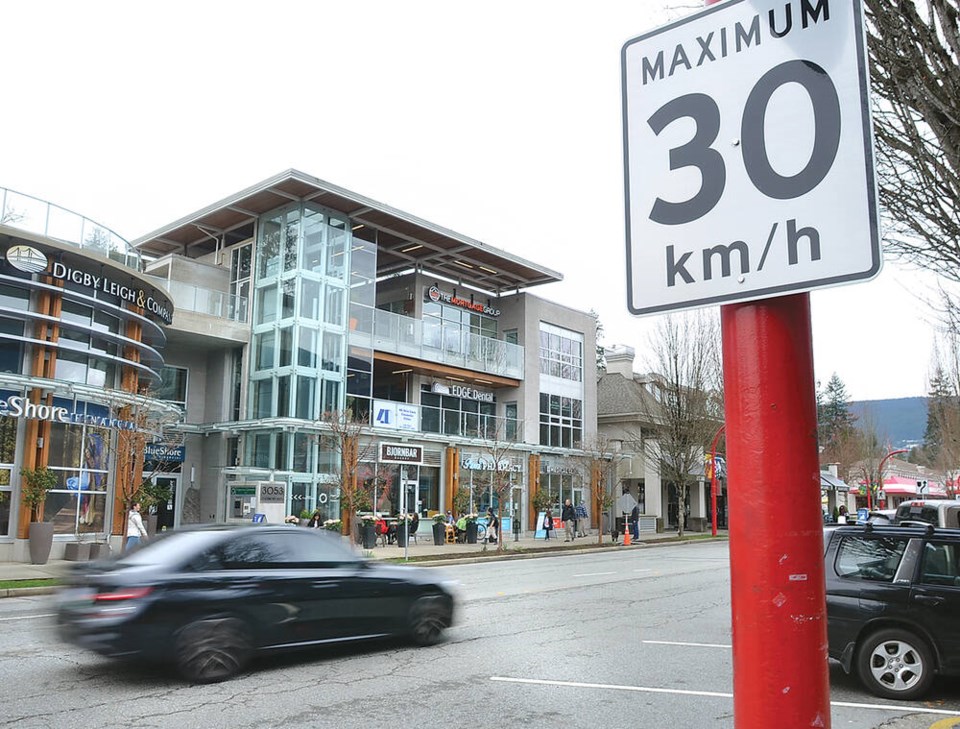Elected officials are expressing frustrations at a lack of movement on creating safer streets in the Edgemont Village neighbourhood.
At a workshop on Monday, staff from North Vancouver District told council that a pilot of putting 30 kilometre per hour signs along Edgemont Boulevard has had virtually no impact on traffic patterns in the area.
Since the 30 km/h signs were put up at last year, staff haven’t seen evidence of changing driver behaviour around Edgemont, nor have they seen cars “rat running” on side streets to avoid the new, lower-speed areas, said Wendelin Jordan, section manager of transportation for the district.
“Neither before nor after dropping the speed limits do we see very strong evidence of vehicle speeds exceeding 50 km/h in the village core,” he said.
Feedback gathered by staff, with core input from the Edgemont Village Business Association and the Edgemont and Upper Capilano Community Association – both which previously lobbied for slower speed limits in the area – was “generally supportive” of the pilot, Jordan said.
“Both associations also pointed out that they liked it as a first step, but would like to see additional measures long term,” he said.
Next steps include additional data collection in Edgemont, as well as following through on an application for TransLink funding to add a traffic signal at the Highland Boulevard intersection, Jordan said.
Staff then spoke to a different but related initiative to standardize what reduced-speed zones look like in the district, and then to generally expand 30 km/h zones.
End data collection and put in solutions, councillors say
Coun. Lisa Muri thanked staff for the information, but said it’s not what her motion asked for.
“Obviously, we’re going to have to be very explicit going forward with council motions, because this motion was about slowing people down in Edgemont Village, and dealing with speed [and] pedestrians,” she said. “It’s now turned into a 30 km/h discussion throughout the district,” she said.
“So my question is, how are we going to reduce the speed and Edgemont Village? I’m sorry, I’m becoming so frustrated with simple solutions that turn into projects that we don’t ask for,” Muri said.
“Where are the raised crosswalks? Where are the bulges? Where are the ways to slow people down so it’s safer?” she asked.
As engineers, you first have to identify a problem, and then undergo statistical analysis, explained Gavin Joyce, general manager of engineering, parks and facilities. It’s no surprise that the speeds are similar after putting in the 30 km/h signs in, but data collection has to happen before next steps like public engagement, he said.
“It sounds easy when you say it like that, but it doesn’t result very often in solving the problem,” Muri replied. “I think it’s simple to slow cars down in areas and we’ve done it for years. You put speed tables in, raised crosswalks, etc.”
Joyce said those changes may not be backed up by speed data, traffic analysis or accidents. “But there might be a clear perception from the businesses and the community that there is a problem there that we should address,” he said.
Taking a similar stance to Muri, Coun. Catherine Pope said she wanted to shift gears to the realm of solutions.
“What I’m hearing is the analysis that has been done so far … [is] not seeing significant evidence of change, no rat running in surrounding areas, volumes and speeds haven’t changed,” she said. “And we want to do more study. This makes no sense to me. Let’s just end this study, and get on with solutions.”
Staff’s intention was to finish the 12-month pilot, said Peter Cohen, senior project manager.
“If council wants to provide us with direction to halt continuing that further and to go straight to solutions, staff can take that as direction,” he said.
But one traffic calming measure already cleared from an engineering perspective is a traffic light at Edgemont and Highland.
“Just from the numbers, the sheer volume of pedestrians alone … it automatically identifies itself as needing to be signalized from a safety perspective, Cohen said.
However, installing the traffic signal would require a TransLink grant, as the cost isn’t in the current budget.
No date has been set publicly for this matter to come back to council.




